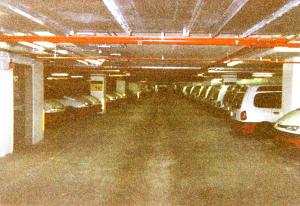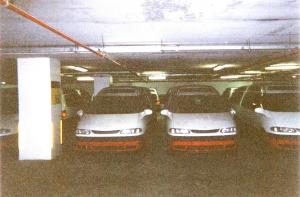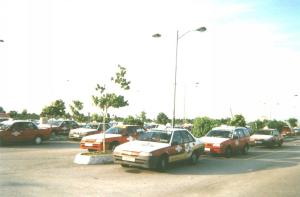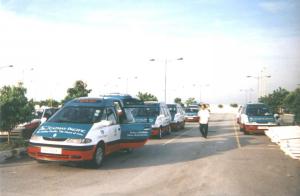 |

|
A tangled tale may be told of haze, environmentally friendly automobiles, tourists, an oil company, and an airport. It is a case study of how local politicians and their greed adversely affect the efficiency of corporations directly under their supervision and control.
Oil was discovered in Malaysian waters. This led to a national oil company titularly titled to all the people of Malaysia in undivided shares. The ministers of the country are entrusted with overseeing its management and appointing skilled executives to derive maximum returns for what is a major source of national income, though from a non-renewable resource.
The activities of the national oil company have not been subjected to critical scrutiny, and there are billions of dollars not now accounted for. The prime minister and the on-lam finance minister do not allow any objective external auditing to discover in which direction the diverted dollars disappeared.
The oil reserves of Malaysia, at present rates of production, are expected to be exhausted within fifteen years. But there are ample reserves of natural gas. The market for natural gas needs to be developed. Toward this end liquified natural gas facilities have been built, ships purchased to transport the product, and new plants built to convert natural gas into other useful fuels.
Malaysia derives significant income from the tourist business. Tourists do not like haze, and there is a history of haze in Malaysia, usually blamed on Indonesian land clearing fires or local internal combustion engines. The Indonesian fires are out, but the haze continues. The focus now is on the exhaust of internal combustion engines.
Diesel engines in poor condition emit significant smoke in Malaysia. There are thousands of diesel lorries and buses on the roads of Malaysia, especially in the Federal Territory of Kuala Lumpur. In addition there are over a million motor bikes, many of which have older two-cycle engines, notorious for their emission of smoke and fumes. To these must be added Kuala Lumpur's 17,000 taxi cabs, which may be compared with only 8,000 in New York City.
Natural gas engines are environmentally friendly. If these engines were used exclusively, the amount of noxious emissions discharged into the air by buses, lorries, cars and motorbikes would be significantly decreased. Petronas found the prospects interesting. Several birds could be killed with one stone.
A market would be developed for the excess natural gas, oil reserves would be extended, the haze would be reduced, and the tourist business would be enhanced. It seemed a sure winner. One need only calculate the costs and project a rate of return.
Petronas decided to supply pressurised natural gas to some of its petrol stations. Special pumps were installed to dispense natural gas to customers, who were existing taxi companies accepting Petronas's offer to subsidise the installation of additional tanks and carburetors to allow their cars an option to run on either petrol or natural gas, at the flip of a switch.
Underground lines were laid cross country to selected stations, dispensing pump equipment was installed, and the number of converted cabs began to increase until now lines form for the frugal fuel. Natural gas is sold at a very attractive price to entice taxi company owners to participate in the exercise.
Seen as vertical integration, the investment in natural gas delivery systems is realistic. The manner in which the various contracts were given is not today's subject, and will be treated as a necessity in order to bring the idea to fruition. There is another related business decision, however, that attracts attention, raising questions about the executive capability of the Petronas management.
Several years ago Petronas decided to enter the taxicab business. A fleet of 1,000 specially designed taxi cabs were purchased from Renault of France. They were to be equipped with engines designed to burn exclusively natural gas. The vehicles were duly shipped to Kuala Lumpur, where they were licenced to prowl the city streets. They are large multi-purpose vans (MPV), capable of carrying five adults and luggage to the new KLIA airport.
But the attractive red and white vans have had difficulty finding room on the streets, and therefore are to be found parked, two and a half years later, in the lower level of the KLCC twin towers parking garage. There is adequate parking because the building lacks tenants. The twin towers today stand as a tourist attraction, a movie set, an air navigational hazard, a venue for public protest of government folly, a swimming pool for toddlers, and now a taxi parking garage.
Over 200 of the new cabs have been put into service under the Enviro label. Another 100 serve as a source of spare parts in the maintenance yard. There have been serious maintenance problems, and Petronas has facilities to perform repair and upkeep located in Shah Alam. Part of the reason for the big repair costs is found in the fact Renault failed to follow the specifications. The engines in the 1,000 cabs are not designed to burn natural gas.
This helps to explain the excessive number of engine failures due to burned valves. This problem was verified by a visiting Renault engineer who came to Kuala Lumpur with the Renault Formula One team. No one in Kuala Lumpur seems aware of this unfortunate fact, and the Renault engineer has not felt it necessary to put the buyers wise.
If someone told you that a thousand new taxicabs were parked for over two years in the lower level parking garage of the KLCC, you would rightly be sceptical, especially if you had recently parked there. The environmentally friendly cabs are visible to the public, though they have been placed on the lower deck and access is roped off. These pictures show the taxicabs gathering dust in the KLCC basement parking lot.


In anticipation of increasing public curiosity, most of the MPV's have been shuttled out to Shah Alam, where they stand in the hot sun, carefully concealed behind a high fence, awaiting better fortunes. If you want to see them, bring a small ladder.
There are three types of cabs in waiting corrals at KLIA. First are the white limousines, many with their space age bubble yet atop. This strange plastic dome was designed to conceal an advanced satellite position system, computer-linked to give accurate information of the vehicles whereabouts. The contract for the system was given to a favored friend on the basis of super salesmanship. It was indeed high tech. No other country uses it. It was destined to be another first for The Malaysian Book of Failed and False First Feats.
The system was highly ballyhooed. The system was bought. But it never worked. There was interference with the airport radar, and thus the high tech idea was quietly shelved. A smart idea got the contract, but it was not tested for feasibility, and the money was wasted. Many of the empty plastic domes still remain atop the limousines, a reminder that the race for development requires engineering study and testing for feasibility. There must be market research to determine demand.
Though a monoply was given to the limousine company, the failure to provide the promised level of service has required that the monoply be canceled. As in the case of the Renault engines, someone must verify that the salesman can and has delivered the promised goods.
In countries where there is an appreciation of these requirements, failure is followed by a finding of fault. The future of responsible decision makers becomes cloudy, and there may be a rain of heads. Not in Malaysia. In Malaysia no one is ever held accountable, and the problems are quietly written off as an unfortunate loss for the poor taxpayers, who are daily getting poorer.
Because executives know they will not be held accountable for mistakes, performance is far over par for the course. Thus the important traits associated with superior business acumen fail to develop. Failures are followed only by more Mercedes Benz cars, more mansions on the hill, and more shares in the account. Fat in the wallet and fat in the head mark the Malaysian businessman, especially those totally dependent on patriarchy, payoffs and political patronage.
These two pictures show the two types of city cabs, each in its assigned waiting corral, on queue to fill the void caused by poor limousine service. In the first picture are the standard four-door sedans, many with the natural gas conversion package installed.

In a second corral are the new Petronas MPV cabs.

The drivers wait their turn patiently, quietly cursing the touts who skirt the queue in private cars, cruising smoothly to the arrival dock, where tired arriving passengers are easily diverted into their un-painted, un-metered, un-licenced, un-regulated private vehicles. The passengers have no way of knowing there are lots of legal cabs waiting out in the sun.
The chairman of Petronas is at his air conditioned desk high atop the empty twin towers, gazing out into the haze. Far below, to the southwest, 700 new MPV's, road taxes paid afresh, stand silently saddled under the hot Shah Alam sun, sidling behind high fences, awaiting a courtesy call to conquest.
YOU CAN VASTLY MULTIPLY THE POWER OF THE INTERNET
Write to Harun Rashid: harunrashid@yqi.com
The URL of this page is http://home.yqi.com/harunrashid1/